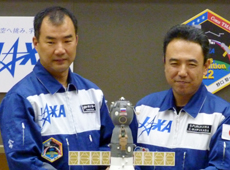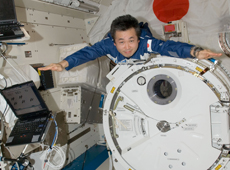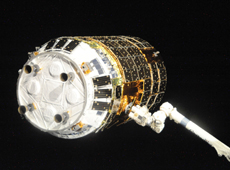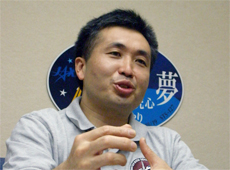Q. Astronauts Soichi Noguchi and Satoshi Furukawa are scheduled for long-duration missions in space in the near future. What's the agenda for them?

Astronauts Soichi Noguchi (left) and Satoshi Furukawa, scheduled for ISS expeditions
Various data can be obtained as a result of a Japanese astronaut going to space. The more of us go, the greater the range of scientific experiments that can be carried out, which allows us to accumulate valuable new data. We can also expect interesting results from educational and art activities in the microgravity environment. For example, during my mission, we carried out unique experiments chosen from applications by the public. We also tried some art experiments, such as dancing in a weightless environment. I believe that new agenda are born in the process of trying out many different things, and further discoveries are made from there. I hope that the next Japanese astronauts flying on long-duration missions in space will try as many new and different things as possible.
Q. How would you like to use your space experience in the future?

Astronaut Wakata in the Russian Service Module Zvezda (Courtesy of NASA)
I had been on two short shuttle flights in the past, but a long-duration mission was an absolutely new and different experience for me. Having done this, I would like to support my astronaut colleagues for their space flights. Also, I would like to apply what I have learned throughout my career as an astronaut, and contribute to the success of Kibo and the entire ISS project, as well as to future human space activities of Japan and the world.
Q. Did you gain a sense of real possibility that humans could go to Mars or live in space in the future?

Astronaut Wakata with water recycled on the ISS (Courtesy of NASA)
I think that we already have the technology to go to Mars, and that we will be flying to Mars in the near future. You could say that human space exploration is in the long run in part crisis management for humans to ensure the survival of our species. But developing the knowledge and technology for our survival in space is not only about expanding the human frontier into space; it also generates new technologies that can help us protect the Earth's environment, such as efficient solar power generating capability.
As we progress with human space activity, it is crucial to think deeply and consistently about how it can benefit our daily life on Earth. For example, during my mission, we started using a urine recycling system, which turns urine into drinking water. We drank this water. It tasted as good as regular drinking water. To fly as far as Mars, we must have a complete water recycling system, since we can only take a limited amount of water with us. Apart from the water circulation system, the ISS is equipped with various systems similar to those we have on Earth to ensure our survival, such as temperature control and CO2 removal. In that sense, the ISS can be called a "mini-Earth." I am sure that the technology developed for sustaining life in space will increasingly contribute to the protection of the environment on Earth.
Q. Do you think you could have stayed in space longer than you did?

Astronaut Wakata traveling in Kibo (Courtesy of NASA)
This is a very interesting question. The Russian cosmonaut Valeri Polyakov stayed on the Mir space station for 14 consecutive months. In fact, on March 15, when I was launched into space, and 2 days later, on March 17, when my shuttle docked with the ISS, I asked myself how long I could live on the space station. I had the impression that the ISS was quite a comfortable living quarter. Thus, I estimated I could be there for a year. I was curious to see how my feelings would change as time passed. Four and a half months later, just before my return to Earth, I asked myself the same question, and thought I could handle staying there for another year. Making a comprehensive judgment based on the living environment, the volume of work, the life pattern, food, and psychological support I was given, I thought that, if I tried, I could stay in space for one year and a half-another year in addition to my 4½ months in space.
Q. What are your hopes for Japanese human space activity?

Japan's first H-II Transfer Vehicle, docked with the ISS in September 2009 (Courtesy of NASA)
First of all, I would like to see the continuous operation of Kibo , as well as the success of the ISS project. The assembly of Kibo was completed in three stages: the Experiment Logistics Module-Pressurized Section was attached in March 2008. The Pressurized Module was added in June 2008, and the Exposed Facility in July 2009. Despite the complexity of its systems, Kibo has not had any major problems. I think this is due to the great quality control capacity of the Japanese space technology. It is extremely challenging for humans to live and operate experiment facilities in the harsh environment of space. If you make an operational mistake, a serious accident could happen, causing fatal damage, such as a fire or rapid depressurization.
I think it's important that Japan's human space activity in the future benefit from the technologies and knowledge we gain from developing and operating Kibo. And, I hope that our country, as a world leader in technology, maximizes its areas of strength, such as robotics technology, and greatly contributes to the advancement of human activity in space.
Furthermore, while future human space projects are expected to progress with international cooperation, it is critical for Japan to expand into space more proactively, by building our own space transportation system. For instance, I think Japan needs to be able to make human lunar exploration happen on its own initiative. Whether we go to the Moon or to Mars, the goal is to expand our frontier in space. But in the course of this, we must not lose sight of the goal of developing new technologies that will benefit our daily life. I believe it is essential for Japan to make progress in space development, including human space activity, always remembering why we go to space.
Q. What are your dreams for the future?

I would like to contribute to the success of the ISS project as a Japanese astronaut. I would also like to increase awareness of Japan's significant contributions to the advancement of space development, such as Kibo and the personnel working on the ISS project, for example. And I dream of building a Japanese-made spaceship as a transportation vehicle between Earth and a low-Earth orbit, so that many Japanese and overseas astronauts can take off into space from the Tanegashima Space Center in Japan. Q. Finally, do you have a message for Japanese readers?I am so grateful for the many messages I received during my stay on the ISS. Your support certainly helped me carry out my long-duration mission in space for 4½ months. I am very pleased to be able to complete my mission safely.
In December, Astronaut Soichi Noguchi is scheduled to take off for a long-duration mission on the ISS. At the beginning of next year, Astronaut Naoko Yamazaki will be on board a space shuttle, and after that, Astronaut Satoshi Furukawa is scheduled for a 6-month mission on the ISS. Please keep an eye on the activities of the Japanese astronauts. Your continued support is much appreciated.
Ph.D., JAXA Astronaut
Wakata received a Doctorate in Aerospace Engineering from Kyushu University. In 1989, he joined Japan Airlines, where he worked as a structural engineer. In 1992, Wakata was selected as a Mission Specialist candidate by the National Space Development Agency of Japan (now part of JAXA) for the assembly and operation of the International Space Station(ISS) and the Japanese Experiment Module, Kibo. In the same year, he began his astronaut training at NASA, qualifying as a Mission Specialist in the following year. In 1996, Wakata flew on space shuttle mission STS-72, becoming the first Japanese Mission Specialist to fly in space. In 2000, he became the first Japanese Mission Specialist to work on the assembly of the ISS, flying on space shuttle mission STS-92. In 2009, Wakata flew as a Mission Specialist on STS-119 and STS-127, and served as Flight Engineer on ISS Expedition missions 18, 19 and 20. He became the first Japanese astronaut to perform a long-duration space flight on the ISS, staying for 4½ months, and to fly on the Soyuz TMA spacecraft.Teamwork between ground and space is the key to success
Space Medicine Contributes to Medical Advances on Earth
A Mission with Astronaut Wakata